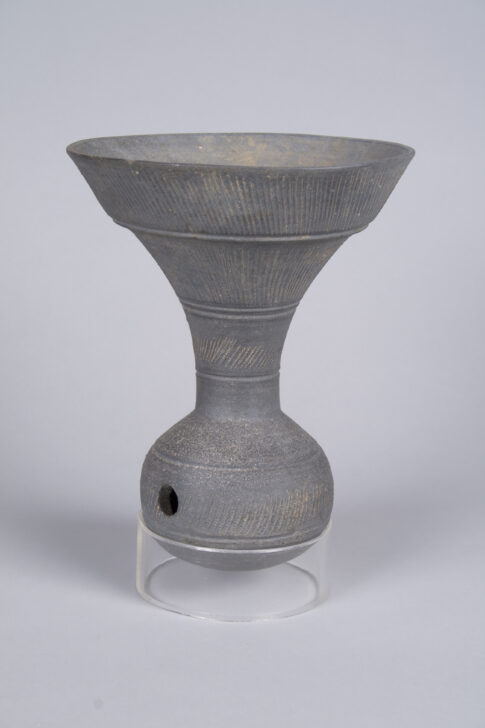Sueki ware hasô
Japanese

Description
Sue ware Hasō (Wine Server)
Japan
Kofun period (300-538)
Fifth or sixth century
Stoneware, gray and unglazed
Museum Purchase made possible by the Margaret Watson Parker Art Collection Fund, 2002/1.231
This beautifully preserved stoneware vessel is designed to serve as a pouring vessel: originally a bamboo spout would have been inserted into the round hold in the globular base of the vessel. The impractical shape (a small body and a dramatically flaring mouth) and the care with which the surface has been decorated tell us that this would have been a high-status object, probably made for used in funerary rites for the elite. It is stoneware, and the dark gray color comes from the reducing atmosphere in the kiln. Haso, as vessels with this shape are termed in Japanese, are generally found in the Kansai area of Japan. This piece is thought to date from the late sixth to the seventh century.
____________________________________________________________
Sue of Sueki ware was the first high-fired pottery to be produced in Japan. It was introduced in the mid-fifth century, probably by a class of émigré Korean craftsmen, as the technology is strikingly similar to that found on the Korean peninsula. These pots are thrown on a fast wheel , and fired in a Korean-style “anagama” [hole-in-the-ground] kiln, made of a single tunnel-like chamber half buried in the ground along the slope of a hill. Sueki wares usually have a very thin and hard body, made of unglazed blue-gray clay fired at temperatures of 1,100 to 1,200 degrees C.
The name “sueki” means “an object set [in a special place]”. Not designed for everyday use, these pots were placed on the ceremonial altars in front of burial mounds of the elite. Sueki often have complex, even compound shapes; many have rounded bottoms and were designed to be displayed on separately formed stands. Over 2000 sueki kilns have been discovered in Japan.
With its nearly globular base, tall neck and dramatically flaring rim, this pot is a particularly elegant example of a hasô, a pouring vessel. A short segment of bamboo would be inserted into the round hole in the body of the vessel to serve as a spout. Note the sensitivity with which the craftsman has decorated the work with bands of precise combed designs. Sueki wares in such fine condition as this example are extremely rare, even in the finest national museum collections in Japan.
Maribeth Graybill, Senior Curator of Asian Art, July 2002
Usage Rights:
If you are interested in using an image for a publication, please visit https://umma.umich.edu/request-image/ for more information and to fill out the online Image Rights and Reproductions Request Form.